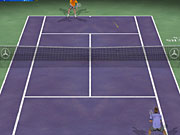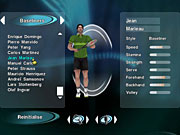Tennis Masters Series 2003 is a step in the right direction for Microids' fledgling arcade sports series. The follow-up to Tennis Masters Series 2002 addresses many of its predecessor's problems, smoothing out player movement, tweaking the AI, and enhancing the graphics. Unfortunately, the previous game had so many issues that these renovations can only do so much. Tennis Masters Series 2003 is a pretty lightweight tennis simulation, though it's clearly on the right track and is much more enjoyable than last year's game.

These improvements seem like the result of fan feedback. One of the most common complaints that players made about the first game was that its controls weren't responsive. Your player lumbered about the court, more like an offensive lineman than a lithe tennis pro, and had an unfortunate tendency to pause after shots, almost as though he were admiring his last stroke. Unfortunately, this pause would often cause you to miss your next shot, even if the ball landed just a few feet away. Considering the fact that computer-controlled opponents would mercilessly fire killer shots at you, the original game could often be frustrating.
Thankfully, the control problems have been addressed in the sequel. Even the slowest players now move with more agility, so you won't have to damage your keyboard or gamepad in a desperate attempt to get from one sideline to the other. And the annoying pause has also been removed. But Tennis Masters Series 2003 apparently went too far in the other direction. In the previous game, you had to push too hard on the gamepad and struggle to get to the ball. In the new game, you're so quick on your feet that it's easy to overshoot your target. Movement on the court seems more like ice-skating than running. This is an improvement on the way things used to be, in that you can more readily compensate for being too quick than for being too slow, but you still have to fight with the controls. You never feel like you have complete control over your player.
The gameplay has progressed in other areas as well. The serve interface has been changed from a basic bar to a round meter that looks and acts a lot like the swing mechanism used in many golf games. It's a welcome change that makes serving the ball a lot more challenging. Putting the ball in play isn't automatic, as it used to be, in that you can't put full power behind your serves and expect them to always land inbounds. Double faults are much more common in the new game, even after you've gotten accustomed to the new meter. Even computer players double-fault now.
And in Tennis Masters Series 2003, matches aren't as predictable as they were in the first game. Computer players are no longer ball-returning automatons--they make unforced errors and can be simply outplayed. While they can be fooled more readily now and will hit shots out of bounds on a regular basis, they are also more prone to making surprising shots and turning your tactics against you. You'll see a larger variety of winning shots because of this, although points still end very quickly. Even the longest rallies last no more than four or five volleys, which may be realistic on the men's pro tour these days, but doesn't provide much opportunity for a drawn-out, exciting duel.
The new game's graphics are better as well. Players have more-distinct movements and dramatically improved animations. The skipped frames and occasional slowdown of the earlier game have also been eliminated. This, plus more-detailed stadiums, the addition of TV-broadcast-style cutscenes between points, and the inclusion of an opening cinematic that features a nifty riff on Pong, upgrades the overall presentation to the point where Tennis Masters Series 2003 can compete with the best in the business when it comes to look and feel. However, the game's sound doesn't compare to its appearance, since there is no commentary and the racket and crowd effects are subdued.
The only other significant addition that the new game makes is a powerful new player and stadium editor. Like its predecessor, Tennis Masters Series 2003 features only generic male tennis pros. Even though the game bears the ATP logo and the Tennis Masters Series license, all the players have made-up names. Then again, professional tennis isn't as much in the public eye these days, so you might not even notice. Still, it's disappointing that Microids didn't get at least a few stars into the game, or any female players at all.

Otherwise, the new game has the same flimsy career mode as the original. You progress from one tournament to another, slowly building skills to the point where you can compete with the top seeds. It's somewhat compelling, although the road to the top takes a long time to travel and you repeat the same circuit of nine stadiums over and over again. The game doesn't have any online support, although you can get into singles and doubles exhibition matches on a single machine or on a local network.
Considering how many improvements it makes to the series, Tennis Masters Series 2003 is a fairly solid tennis game. If you're looking for a complete tennis simulation, you won't find it here, though anyone searching for a quick game of tennis should find a lot to like, including the game's budget price tag, provided they don't expect too much.